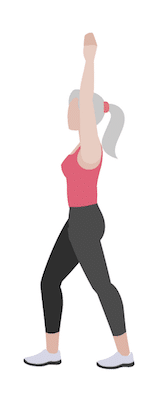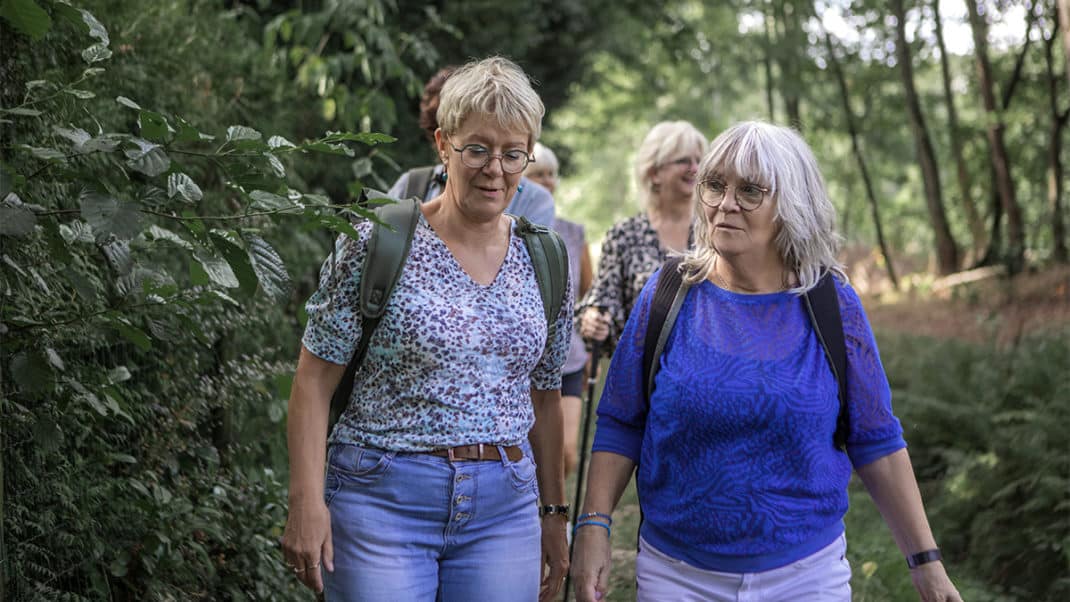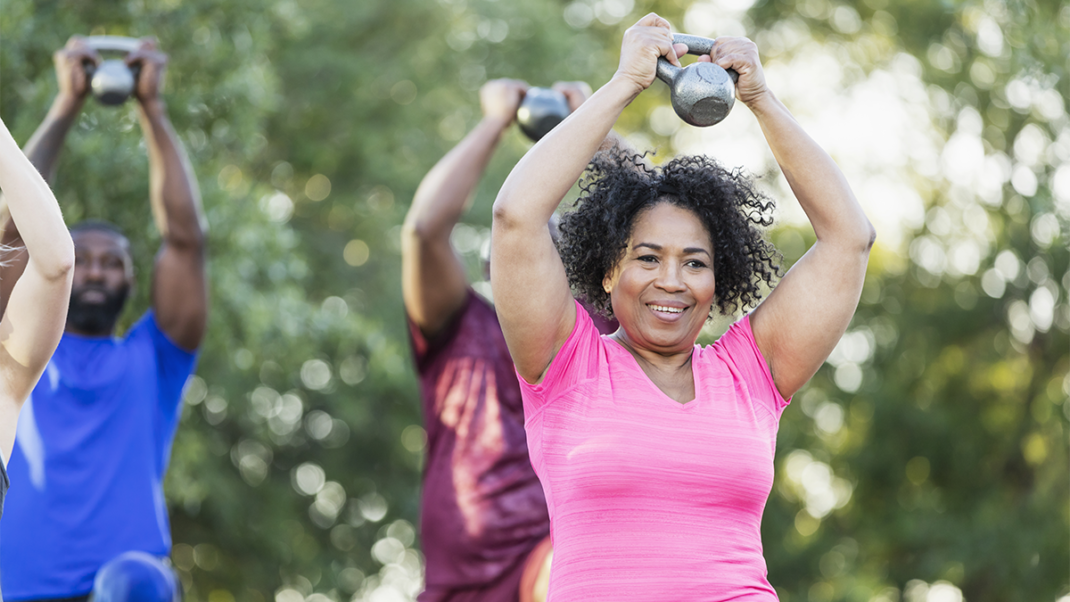Spotting and Fixing Flaws in Walking Biomechanics

All illustrations in this article are adapted from The Biomechanics Method®.
Participating in a program of regular exercise is a good idea at any stage of life, but particularly as we get older. Exercising frequently and consistently has many documented benefits, including promoting good health, preventing disease, enhancing mental health and physical capacity, aiding recovery from injury and illness, minimizing the effects of aging, and improving one’s ability to handle the physical demands of life (Bird, Smith & James 1998).
One of the most popular forms of exercise is walking, with approximately 100 million people in the U.S. alone engaged in a regular program (Sewell, Watkins & Griffin 2012; Hawkins & Hawkins 2011). Walking is an ideal physical activity for older exercisers because they generally feel confident performing the required movements—after all, they’ve been doing them all their lives (Williamson 2007). Though baby boomers and older clients appreciate the simple, healthful benefits of walking, a combination of musculoskeletal dysfunctions and everyday aches and pains can make it difficult to walk regularly (Lee et al. 2008).
Fortunately, you can identify the common movement imbalances and compensations people develop during a lifetime of walking. Once you’ve noted these issues, a corrective exercise program can help your clients overcome them (Solberg 2008).
Walking Movement Challenges
The gait cycle requires the foot, ankle and surrounding soft-tissue structures to have enough mobility and flexibility to accept and transfer weight forward and from side to side (Chapman 2008). Weight transfer also requires the hip on the load-bearing side to have enough mobility and flexibility to let one leg travel behind the body so the other can lift off the ground and swing forward. The hip must be mobile and flexible enough to rotate inward so that weight transfers to the other side of the body before the swinging leg touches the ground (Chapman 2008; Price & Bratcher 2010).
Additionally, the structures of the upper body need enough flexibility and mobility to minimize lower-body stress during repetitive walking motions. Swinging the arms and rotating the torso help to propel and coordinate the lower body during gait (Chapman 2008; Price & Bratcher 2010). All of these movements minimize stress to the feet, ankles, knees, hips, lower back, shoulders and neck.
Common Movement Imbalances and Compensations
The most common movement imbalances and compensation patterns from walking show up in the sagittal (forward and backward movements), frontal (side-to-side movements) and transverse (rotational movements) planes. Addressing these problems can improve your clients’ mobility and flexibility, reducing their likelihood of developing pain or injury (Whittle 1991; Price & Bratcher 2010).
Sagittal-Plane Compensations
Walking involves many forward and backward movements. For instance, bending the ankle forward correctly and transferring weight onto one foot when walking is predominantly a sagittal-plane motion (Knudson 2007). The motion of the leg traveling behind the body is also a chiefly sagittal-plane movement.
When walking, someone who lacks the requisite flexibility and mobility to effectively perform these movements will likely compensate by transferring other parts of the body forward (Yates 2009). For example, a client may round his shoulders and upper back (excessive thoracic kyphosis) or jut his head out to tip his body weight frontward to make up for a lack of forward mobility in the ankles and hips.
Another client may tilt her pelvis down at the front (excessive anterior pelvic tilt) to advance her center of gravity. This pelvic tilt is usually accompanied by overarching of the lower back (excessive lumbar lordosis).
It’s easy to see these compensation patterns in your older clients by watching their gait from a side-on perspective. While compensations may help them continue to walk (albeit incorrectly), these dysfunctional movement patterns can lead to neck and shoulder pain, disk degeneration, lower-back pain, sacroiliac joint dysfunction, and hip pain.
Frontal-Plane Compensations
Walking also involves side-to-side movements, such as rolling the foot and ankle toward the midline of the body to transfer weight from left to right and vice versa. In older walkers, restrictions in the feet and ankles can prevent lateral movement, causing compensation patterns that show up as deviations elsewhere (Whittle 1991).
For example, people with limited side-to-side foot and ankle mobility may tilt or bob their head from side to side while walking toward (or away from) you. You might notice a marked drop in one shoulder (or both) as they walk, indicating that the spine is swaying excessively from side to side to compensate for frontal-plane immobility in the feet and ankles.
If you don’t address these issues, clients may develop neck, shoulder and back pain.
Transverse-Plane Compensations
Walking requires hip rotations that transfer weight and regulate swinging of the arms.
Clients with poor mobility and flexibility in their hips and torso often develop compensation patterns (Whittle 1991). For example, if the torso does not rotate effectively, disproportionate or unbalanced arm swinging can become a problem (on one side or possibly both sides), causing excessive stress to the neck and shoulders. Alternatively, the lumbar spine may suffer excessive rotation if the hip cannot rotate effectively. This over-rotation can increase shearing forces on the spine and lead to further disk degeneration. You can identify these movement imbalances by watching your elderly clients walk toward you and away.
Retraining Strategies
Integrating corrective exercise strategies into your older clients’ programs will increase flexibility and mobility. It’s best to adopt a step-by-step approach, rejuvenating and regenerating soft-tissue structures with self-myofascial release techniques before introducing stretches and joint mobilization techniques.
Here are six corrective exercise strategies (two each for the ankles, hips and torso) to address some of the most common flexibility and mobility issues that affect older adults.
Ankles
Calf massage. This exercise improves the flexibility of the soleus and gastrocnemius muscles, mobilizing the ankle to bend forward more effectively. This allows the body to transfer weight over the foot when walking.
Sit on the floor (against a wall if needed) with legs outstretched. Place a tennis ball on the floor and rest the back of your calf on top of the ball. Find a sore spot on your calf. Maintain pressure on it for 5–10 seconds until it releases, and then move to the next spot. Do each leg for about 1–2 minutes. (Note: If clients have difficulty getting onto the floor, they can do this exercise sitting on a chair with their outstretched leg on top of another chair or stool.)
All illustrations in this article are adapted from The Biomechanics Method®.
BOSU® Balance Trainer calf stretch. This exercise improves flexibility in the foot and ankle when the leg is behind the body. This stretch also mobilizes the hip by internally rotating it when the foot rolls inward.
Use a split stance on a BOSU® ball. Place both hands on a wall or counter for balance. Keeping the back leg straight, push the heel of the back foot down to stretch the gastrocnemius. Roll the foot and ankle of the back leg inward and then roll it outward. Repeat this movement, rolling the ankle and foot in and out while keeping the back leg straight. As you perform each move, keep your hips square and torso upright. Perform 8–10 repetitions with each leg. (Note: If clients have difficulty balancing on a BOSU ball, they can perform this exercise with their feet on the ground.)
Hips
Hip flexor massage. This exercise improves flexibility in the hip flexor muscles, helping to mobilize the hip and leg so they can travel behind the body (and rotate inward) more effectively.
Lie face down on the floor with legs outstretched. Place a tennis ball under the front of one hip. Find a sore spot. Maintain pressure on it until it releases (5–10 seconds), and then move to the next spot. Release all sore spots from the front of that hip all the way up to the side of your bellybutton. Do each side for about 1–2 minutes. (Note: If clients have difficulty getting onto the ground, they can perform this exercise lying in bed with a book underneath the ball to prevent it from sinking into the mattress.)
Step back with arm raise. This exercise improves the leg’s ability to travel behind the body (and the ankle’s ability to bend forward over the foot), mimicking the way the body should transfer weight over the weight-bearing leg when walking.
Step back with the right leg while raising the right arm overhead. As you perform this movement, make sure both feet face forward, and do not overarch the lower back. Complete the movement on the right side by stepping forward with the right leg while bringing the arm down. Then step backward with the left leg and raise the left arm to complete the movement on the left side. Perform 6–10 repetitions on each side, maintaining proper form: feet facing forward, hips square and shoulders down throughout the movement.
Torso
Tennis ball on lower back and lower ribs. This exercise improves flexibility in the posterior oblique muscles, promoting trunk mobility and improving torso rotation.
Lie on the floor with knees bent. Place a tennis ball under one side of your spine in the space just above the back of your hips, at the bottom of your rib cage. Find a sore spot. Maintain pressure on it until it releases (5–10 seconds), and then move to the next spot. When you have loosened all the muscles on one side of your lower back and lower ribs, switch to the other side. Do each side for about 1–2 minutes. (Note: If clients have difficulty getting onto the floor, they can perform this exercise lying in bed with a book underneath the ball to prevent it from sinking into the mattress.)
Wall stretch. This exercise improves torso rotation and coordinates it with the feet, ankles and legs, mimicking correct whole-body walking mechanics.
Stand sideways to a wall in a split stance with the foot closer to the wall forward. Rotate the upper torso toward the wall, but keep the head, hips, legs and feet facing straight forward. Place both palms flat against the wall, and hold the stretch for about 20–30 seconds without shifting or bending the spine or hips to the side. Repeat on the other side.
Keep Them Moving—and Walking
A regular walking program provides many physical and mental benefits, especially for older exercisers. When you identify imbalances and compensations in your older clients, you can integrate corrective exercises into their workouts to keep them pain-free and enjoying their daily walks (and health) for many years to come.
- One leg moves forward and touches down, accepting the body’s weight.
- The weight-bearing leg straightens and travels behind the body.
- The non-weight-bearing leg swings frontward and repeats the cycle (Price & Bratcher 2010).
Additional Movements
The arms swing in one direction while the torso rotates in the other direction, helping to propel and coordinate the lower body. For example, as the left leg swings forward, the right arm swings forward to help generate momentum, transfer weight from left to right and keep the body balanced (DeLisa 2005).
|SIDEBAR|
- One leg moves forward and touches down, accepting the body’s weight.
- The weight-bearing leg straightens and travels behind the body.
- The non-weight-bearing leg swings frontward and repeats the cycle (Price & Bratcher 2010).
<
Justin Price, MA
Justin Price, MA, is creator of the BioMechanics Method® Corrective Exercise Specialist (TBMM-CES) program, the fitness industry’s highest-rated CES credential, with trained professionals in 80 countries. He is also the author of several books, including The BioMechanics Method for Corrective Exercise academic textbook, and he was awarded the 2006 IDEA Personal Trainer of the Year. He has served as a subject matter expert for numerous brands and media organizations including ACE, TRX® and BOSU®; the BBC, Discovery Health and MSNBC; Arthritis Today, Men’s Health, Newsweek, Time, WebMD and Tennis; and Los Angeles Times, The New York Times and Wall Street Journal. Learn more about The BioMechanics Method®











